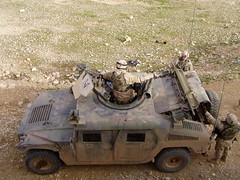The AM General High-Mobility Multipurpose Wheeled Vehicle, or Humvee, has been the workhorse tactical vehicle for U.S. forces since the mid 1980s. There are no fewer than 140,000 examples in more than 15 versions in service with all military branches. The Humvee has been praised for its versatility and ruggedness, but operations in Iraq and Afghanistan have revealed serious shortcomings, including inadequate power generation, limited seating capacity and -- most notably -- the designs vulnerability to roadside bombs.
Building on limited deployments of specialized blastproof vehicles for engineers and bomb disposal teams, the Army and Marines are co-sponsoring programs to buy potentially thousands of so-called Mine-Resistant Ambush-Protected trucks, worth as much as $1 billion, followed by 100,000 or more Joint Light Tactical Vehicles for tens of billions more. The two programs will eventually replace all Humvees with tougher, roomier designs.
 But that will take decades, especially as Pentagon officials attempt to reign in costs. Acquisition czar Kenneth Krieg said in early March that he was considering moving MRAP out of the militarys fast-but-loose rapid-fielding process due to the anticipated scale and cost of the vehicle purchase, which he said demand careful oversight.
But that will take decades, especially as Pentagon officials attempt to reign in costs. Acquisition czar Kenneth Krieg said in early March that he was considering moving MRAP out of the militarys fast-but-loose rapid-fielding process due to the anticipated scale and cost of the vehicle purchase, which he said demand careful oversight.
To keep Humvees up to speed while the military awaits replacements, BAE Systems is proposing a range of high-tech modifications, according to program manager Steve Cortese.
At the Association of the United States Army winter symposium in Fort Lauderdale on March 7-9, BAE showed off a demonstrator with the full range of upgrades, including: a new multi-band antenna that replaces a complex jumble of antennae on existing Humvees; a rear-mounted infrared camera for checking blind spots; pop-out windows for quick escape in emergencies; and a new power management system. Many of these improvements are derived from BAEs work on the Future Combat Systems family of vehicles, slated to make their debut around 2010.
The Advanced Power Management System represents perhaps the most important change. This system, ported from FCS, provides the extra electrical power that the vehicle needs in order to support radio jammers that defeat Improvised Explosive Devices. APMS also has an export function, allowing an equipped Humvee to function as a sort of mobile generator a capability usually seen on hybrid diesel-electric vehicles. APMS turns a standard Humvee into a poor mans hybrid, Cortese says.
The mods are all based on feedback from Iraq and Afghanistan, Cortese adds. Were trying to be sensitive to the needs of the warfighter."
--David Axe, cross-posted at War Is Boring








